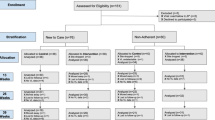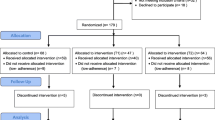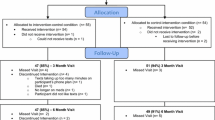Abstract
Online social media and mobile technologies hold potential to enhance adherence to antiretroviral therapy (ART), although little is known about the current use of these technologies among people living with HIV (PLWH). To address this gap in understanding, 312 PLWH (84% male, 69% White) US adults completed an online survey in 2009, from which 22 persons accepted an invitation to participate in one of two online focus groups. Results showed that 76% of participants with lower ART adherence used social networking websites/features at least once a week. Their ideal online social networking health websites included one that facilitated socializing with others (45% of participants) and ones with relevant HIV informational content (22%), although privacy was a barrier to use (26%). Texting (81%), and to a lesser extent mobile web-access (51%), was widely used among participants. Results support the potential reach of online social networking and text messaging intervention approaches.
Similar content being viewed by others
References
Curioso WH, Kurth AE, Curioso WH, Kurth AE. Access, use and perceptions regarding Internet, cell phones and PDAs as a means for health promotion for people living with HIV in Peru. BMC Med Inform Decis Mak. 2007;7:24.
Dunbar P, Madigan D, Grohskopf L, Revere D, Woodward J, Minstrell J, et al. A two-way messaging system to enhance antiretroviral adherence. J Am Med Inform Assoc. 2003;10(1):11–5.
Lester RT, Mills EJ, Kariri A, Ritvo P, Chung M, Jack W, et al. The HAART cell phone adherence trial (WelTel Kenya1): a randomized controlled trial protocol. Trials. 2009;10:87.
Ybarra ML, Bull SS. Current trends in Internet- and cell phone-based HIV prevention and intervention programs. Curr HIV/AIDS Rep. 2007;4(4):201–7.
Ammassari A, Trotta MP, Mussini C, Sora FD, Bellagamba R, Bonora S, et al. The use of a mobile phone intervention based on short message system (SMS) for assisting HIV-infected non-adherent patients to comply with antiretroviral therapy. In: 5th international conference on HIV treatment adherence, Miami; 2010.
Chiasson MA, Hirshfield S, Rietmeijer C. HIV prevention and care in the digital age. JAIDS. 2010;55:S94–7. doi:10.1097/QAI.0b013e3181fcb878.
Simoni JM, Huh D, Frick PA, Pearson CR, Andrasik MP, Dunbar PJ, Hooton T. Peer support and pager messaging to promote antiretroviral modifying therapy in Seattle: a randomized controlled trial. J Acquir Immune Defic Syndr. 2009;52(4):465–73. doi:10.1097/QAI.0b013e3181b9300c. PMCID: PMC2795576.
Fisher J, Amico K, Fisher W, Cornman D, Shuper P, Trayling C, et al. Computer-based intervention in HIV clinical care setting improves antiretroviral adherence: the LifeWindows project. AIDS Behav. 2011;15(8):1635–46.
Lester RT, Ritvo P, Mills EJ, Kariri A, Karanja S, Chung MH, et al. Effects of a mobile phone short message service on antiretroviral treatment adherence in Kenya (WelTel Kenya1): a randomised trial. Lancet. 2010;376(9755):1838–45.
Horvath KJ, Harwood EM, Courtenay-Quirk C, McFarlane M, Fisher H, Dickenson T, et al. Online resources for persons recently diagnosed with HIV/AIDS: an analysis of HIV-related webpages. J Health Commun Int Perspect. 2010;15(5):516–31.
Courtenay-Quirk C, Horvath KJ, Ding H, Fisher H, McFarlane M, Kachur R, et al. Perceptions of HIV-related websites among persons recently diagnosed with HIV. AIDS Patient Care STDs. 2010;24(2):105–15.
Fox S. Peer-to-peer healthcare: Many people-especially those living with chronic or rare diseases-use online connections to supplement professional medical advice. Washington, D.C.: Pew Research Center’s Internet & American Life Project; 2011 February 28, 2011.
Rhodes SD, Hergenrather KC, Duncan J, Vissman AT, Miller C, Wilkin AM, et al. A pilot intervention utilizing Internet chat rooms to prevent HIV risk behaviors among men who have sex with men. Public Health Rep. 2010;125(Suppl 1):29–37.
Fox S. The social life of health information, 2011: Pew Internet and American Life Project: http://pewinternet.org/Reports/2011/Social-Life-of-Health-Info.aspx; 2011.
Gordon C. Commentary on meta-analysis of randomized controlled trials for HIV treatment adherence interventions. Research directions and implications for practice. JAIDS. 2006;43(Suppl 1):S36–40.
Paterson D, Swindells S, Mohr J, Brester M, Vergis E, Squier C, et al. Adherence to protease inhibitor therapy and outcomes in patients with HIV infection. Ann Intern Med. 2000;133(1):21–30.
Simoni JM, Pantalone DW, Plummer MD, Huang B. A randomized controlled trial of a peer support intervention targeting antiretroviral medication adherence and depressive symptomatology in HIV-positive men and women. Health Psychol. 2007;26(4):488–95.
Courtenay-Quirk C, Wolitski R, Hoff C, Parsons J. Interests in HIV prevention topics of HIV-seropositive men who have sex with men. AIDS Educ Prev. 2003;15(5):401–12.
Burgoyne R, Renwick R. Social support and quality of life over time among adults living with HIV in the HAART era. Soc Sci Med. 2004;58(7):1353–66.
Weaver K, Llabre M, Duran R, Antoni M, Ironson G, Penedo F, et al. A stress and coping model of medication adherence and viral load in HIV-positive men and women on highly active antiretroviral therapy (HAART). Health Psychol. 2005;24(4):385–92.
Smith A. 35% of American adults own a smartphone: http://pewinternet.org/~/media//Files/Reports/2011/PIP_Smartphones.pdf. Washington, D.C.: Pew Research Center; 2011.
Singh N, Berman S, Swindells S, Justis J, Mohr J, Squier C, et al. Adherence of human immunodeficiency virus-infected patients to antiretroviral therapy. Clin Infect Dis. 1999;29(4):824–30.
Fogarty L, Roter D, Larson S, Burke J, Gillespie J, Levy R. Patient adherence to HIV medication regimens: a review of published and abstract reports. Patient Educ Couns. 2002;46:93–108.
Madden M, Zickuhr K. 65% of online adults use social networking sites: http://pewinternet.org/Reports/2011/Social-Networking-Sites.aspx. Washington, D.C.: Pew Research Center; 2011.
Acknowledgments
This study was funded by the National Institute of Mental Health (5R34MH083549). We wish to thank the participants of this study for their time and effort.
Author information
Authors and Affiliations
Corresponding author
Rights and permissions
About this article
Cite this article
Horvath, K.J., Danilenko, G.P., Williams, M.L. et al. Technology Use and Reasons to Participate in Social Networking Health Websites among People Living with HIV in the US. AIDS Behav 16, 900–910 (2012). https://doi.org/10.1007/s10461-012-0164-7
Published:
Issue Date:
DOI: https://doi.org/10.1007/s10461-012-0164-7




